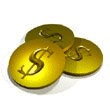 |
by Robert V. Rowe |
 |
|
February 15, 1999
|
R ecently, while looking in my files for something totally different, I came across an arithmetic table which should prove of interest to any serious bettor. It pertains to a bit of research I had been doing, and is reproduced below with an accompanying explanation.
The Field Size heading should be obvious. The second heading pertains to a horse's theoretical winning chance relative to field size, and regardless of any other factor. Our third heading provides the ACTUAL winning percentages that favorites achieved in each field size. Number four provides the average mutuel payoff, and number five gives the gross return on a total wager of $200 (100 bets at $2.00 per). Note that in the "Gross $ Return" column there appears to be a discrepancy inasmuch as the deterioration of returns is not completely uniform. The "180" and the second "173" are out of sync with the rest of the figures. But, it doesn't matter. In any valid statistical study there's bound to be occasional aberrations which, if pursued long enough, will eventually iron themselves out. This study encompassed several thousand races but apparently was still insufficient for the ironing out process to completely resolve itself.
THE IMPLICATION OF THIS TABLE
Our prime concern is in observing how the rate of return (losses) escalate as field size increases. In 5-horse fields if one made 100 mutuel bets of $2 each on 100 favorites the average return would be $185 equal to a 7-1/2% loss overall. On the other hand , wagering on average-priced favorites in 12-horse fields would show a return of only $159 equal to a loss of almost 20%. Many fans seem to assume that longer odds are commensurate with a greater potential for profit. Therefore, a brief study of this table may prove an eye-opener to some inasmuch as it shows that losses tend to escalate as the odds increase (again compare the 5-horse field returns with that of the 12-horse fields).
THE OVERALL TREND
Actually this should provide no surprise due to fact that the OVERALL trend in racing is for losses to escalate in direct proportion to the odds increasing. Expressed otherwise, If one were to indiscriminately make 100 bets at even money the trend would be for these bets to show a far lesser loss than 100 indiscriminate bets on a group of horses that averaged 10/1. This does not imply that one should confine play to short-priced favorites. It does imply that if one is a chronic long-shot bettor he or she should give serious thought to revising their approach. Bear in mind that it's not only possible but quite likely that a short-priced horse could, in reality, be a terrific overlay. Putting this information to practical use in one area, your scribe would suggest giving serious consideration to using relatively short-priced horses as exacta keys, and be extremely cautious about using long shots as keys.
|

